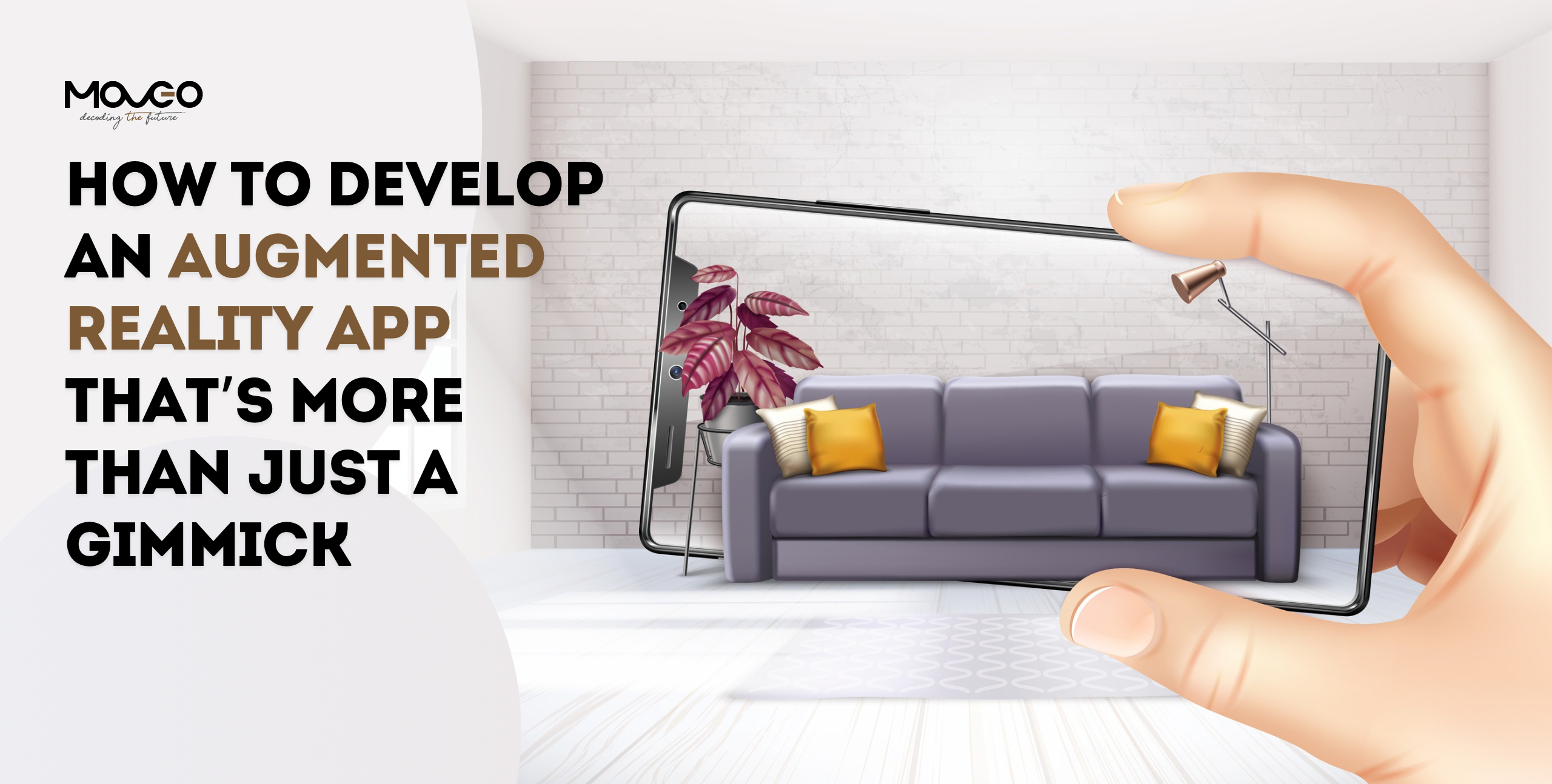Chances are that you’ve used an augmented reality app or AR app very recently, maybe today, or at least this week. Chances also are that you’ve thought about developing an AR app, considering that the global AR mobile app revenue has consistently risen since the launch of Pokemon Go in 2016, and is set to go all the way up to $100 billion by 2028. If that is exciting, here are some more interesting AR app development statistics for you.
According to Shopify, products that offered augmented reality viewing saw 94% higher conversion rate conversion rate during the pandemic compared to those without AR.
U.K.-based hospitals implemented an AR and VR based platform Virti to deal with mental health and support training during the pandemic.
As per Adloid.in, a business-to-business AR solution provider, businesses implementing its online augmented tools for customer engagement witness a 200% rise in sales.
According to a white paper by Infosys, the brands offering customized products are witnessing six to ten times higher growth in revenue generation.
AR App Development is Maturing
Augmented reality app development has already crossed the fancy new tech stage and become a standard customer expectation today. An AR app that lets your customers try on clothes, sneakers, sunglasses, or make-up is quite simply an ecommerce staple. Or one that lets customers rearrange furniture in their room, or see what a building will look like after it is fully built.
In healthcare, AR is revolutionizing patient care, from increasing surgical precision to providing detailed patient education. Real estate apps are also leveraging AR, allowing potential buyers to take virtual tours of properties, making the home-buying process more immersive and convenient. The rapid integration of AR across various industries shows how indispensable this technology is becoming.
Soon, schools will be expected to have augmented reality experience centres built in to their premises, so the students can easily understand everything from human anatomy to particle physics. Developing an augmented reality app is the next big business idea you should be exploring.
AR app development has become one of the most sought-after categories in app development lately. Leveraging advanced technologies like Apple’s ARKit, Google’s ARCore, and Unity, empowers developers to create immersive and interactive experiences that engage users in ways traditional apps simply cannot. These tools not only simplify the development process but also provide the capabilities to push the boundaries of what’s possible, ensuring that your app stands out in a crowded market.
Addressing The Gimmick Part of AR Apps
Yes, we must address the elephant in the, well, title.
A number of excellent AR apps have set the bar high. At the same time, there are apps that barely resemble an app from this decade. A number of try-on apps look like cheap photoshop knockoffs. Movements don’t sync, colors don’t match, and bad apps galore in general.
Don’t be in a hurry to launch you AR app. Take the time to invest in quality, leverage the latest technologies, and ensure your app is something people will actually want to use. Cutting corners on development will only leave you with a product that’s more gimmick than game-changer.
Use only the best tools like ARKit for iOS or ARCore for Android, which provide the framework for precise motion tracking, environmental understanding, and light estimation. These platforms allow for more realistic interactions and smoother experiences. Consider integrating machine learning algorithms to enhance object recognition and ensure that virtual elements seamlessly blend with the real world.
If your app is focused on virtual try-ons, use latest 3D modeling and rendering technologies, like Unity or Unreal Engine, to ensure high-fidelity graphics and accurate representation. Real-time rendering, coupled with advanced shaders and texture mapping, can make all the difference in avoiding that jarring, out-of-place look that’s visible in so many subpar AR apps.
So, choose quality, invest in technology, find the best AR app development team to join forces with, and only then will you create an app that’s truly useful.
Augmented Reality App Development Market: Future Outlook
The global Augmented Reality App Development market is set to experience explosive growth between 2024 and 2031. This rapid expansion is fueled by continuous technological advancements, an ever-expanding range of applications across industries, and increasing consumer adoption.
Tech giants like Apple and Google are investing heavily in AR technologies, with Tim Cook recently stating that “AR is the next big thing that will pervade our entire lives.” This sentiment is echoed across the industry, as companies recognize the transformative potential of AR in sectors such as retail, education, healthcare, and entertainment.
For businesses within this space, the opportunity is clear. Strategic investments in research and development, coupled with innovative partnerships, can unlock new revenue streams and market dominance. Moreover, the diversification of AR applications—from real estate, healthcare, manufacturing, and education, to remote assistance. Customer service, ecommerce and more —ensures that this technology is no longer a novelty but a valuable tool for enhancing customer engagement and operational efficiency.
Step-by-Step Guide to Developing an Augmented Reality App
Here’s a step-by-step guide to building an AR app that truly delivers on its promise. Let’s take a look at how to create a custom AR app with a step-by-step guide that will help you navigate the AR app development process smoothly.
Step 1: Conduct Thorough Research and Analysis
Before diving into the development process, it’s essential to conduct thorough research and feasibility analysis. This step involves evaluating the technical requirements, market demand, and potential challenges associated with your AR app.
Start by researching existing AR apps in your target domain. Analyze their features, user feedback, and overall performance. For example, if you’re building an AR app for retail, examine how successful apps in this space handle virtual try-ons or product visualization. If you’re looking at creating AR apps for education, examine how apps like JigSpace or Froggipedia are making complex concepts accessible. This will help you identify gaps and opportunities for differentiation.
Next, assess the technical feasibility of your AR app. Determine whether the technology needed for your app—such as advanced 3D modeling or real-time object recognition—is accessible and viable within your development timeline and budget. This may involve evaluating the best practices for AR app development and understanding the capabilities of AR frameworks like ARKit and ARCore.
By conducting comprehensive research and feasibility analysis, you’ll gain a clear understanding of the landscape, set realistic expectations, and lay a solid foundation for your AR app development journey.
Step 2: Choose the Right AR Development Framework
Selecting the right AR development framework is crucial. Two of the heavyweights here are Apple’s ARKit and Google’s ARCore. If you’re aiming to develop an AR app for both Android and iOS, leveraging ARKit and ARCore will ensure a smooth experience across platforms. These tools are packed with features that make building AR apps more intuitive and efficient.
ARKit, for example, excels at integrating real-world interactions with virtual elements, making it ideal for developing AR apps with location-based services or object recognition. On the other hand, ARCore provides powerful capabilities for building AR apps that perform well on a variety of Android devices. Knowing how to implement ARKit and ARCore effectively is pivotal in creating a seamless user experience.
Step 3: Design Your AR App User Interface
Designing an AR app user interface requires a careful balance between aesthetics and functionality. The best practices for AR app development involve creating a UI that complements the augmented reality experience rather than overwhelming it. For instance, if you’re developing an AR app for healthcare, your UI should provide clear, easy-to-navigate information without distracting from the primary AR elements.
Consider the placement of controls, the clarity of information, and how users will interact with both real and virtual elements. Effective UI design in AR apps often involves integrating 3D models in a way that feels natural and intuitive.
Step 4: Integrate 3D Models and Object Recognition
Integrating 3D models into your AR app is where the magic happens. They add depth and realism, turning static concepts into interactive experiences. Tools like Unity, with its powerful 3D rendering capabilities, can help you bring these models to life, ensuring they are not just visually impressive but also responsive to user interactions.
Beyond 3D models, integrating object recognition can significantly elevate your app’s functionality. This technology allows your app to identify specific objects in the real world and overlay relevant digital information or interactive elements. For instance, an AR app for museums should recognize an exhibit and instantly display rich educational content, or a real estate app should identify a property and provide virtual walkthroughs. Object recognition transforms AR into a powerful tool for delivering contextually relevant experiences.
Step 5: Choose Your Tech Stack for AR App Development
The tech stack for augmented reality app development will include not just your AR framework but also other supporting technologies. Incorporating AI in AR app development can further enhance user experiences, such as improving object recognition or personalizing content.
Incorporating AI into your AR app can refine object recognition capabilities, making interactions more intuitive and responsive. AI can also play a key role in personalizing content, tailoring experiences to individual users based on their behavior and preferences. Beyond AI, consider technologies like cloud computing for offloading heavy processing tasks, or integrating IoT for real-time data inputs that enrich the AR environment.
The key is to think holistically what additional technologies will not only complement your AR framework but also enhance your app’s unique features and value proposition. By carefully curating your tech stack, you ensure that your AR app is not just functional but also capable of delivering an immersive, cutting-edge experience that sets it apart in a competitive landscape.
Step 6: Test and Deploy Your AR App
Testing and deploying an augmented reality app demands a meticulous approach. The goal isn’t just to ensure that your app functions—it’s to guarantee it performs seamlessly across a wide range of devices and real-world scenarios. Comprehensive testing is essential to identify and resolve any issues related to AR functionalities, such as tracking accuracy, interaction responsiveness, and overall stability. Pay close attention to how your app handles different environments, lighting conditions, and user interactions, as these factors can significantly impact the user experience.
Once testing is complete, it’s time to deploy your app. Whether you’re targeting the App Store or Google Play, adherence to platform guidelines is key to a smooth and successful launch. Each platform has its own set of requirements, so make sure your app meets all criteria to avoid delays or rejections.
By following these steps, you’re not just developing an AR app—you’re creating an experience that stands out in a crowded market. An AR app that not only captures attention but also provides tangible value to its users. Embrace the limitless possibilities AR offers, and let your creativity guide you in building an innovative, engaging augmented reality experience that leaves a lasting impact.
Ready To Build an Augmented Reality App of Your Own?
For those considering a venture into AR app development, now is the perfect time to dive in. The market is not only expanding but also maturing, with a wealth of resources available to guide new developers. The AR landscape is ripe with opportunities. Innovation, growing demand, and diversifying applications are driving this growth, creating a fertile ground for stakeholders to enhance their competitiveness and foster long-term success. Those who seize these opportunities will be well-positioned to lead in this rapidly evolving market.
So get in touch with us today and find out how you can take your ideas to the next level with our expert AR app development services suite, complete with talented designers, experienced developers, and a full-stack app development team at your disposal.


